Master the Art of Air Fryer Chicken Wings

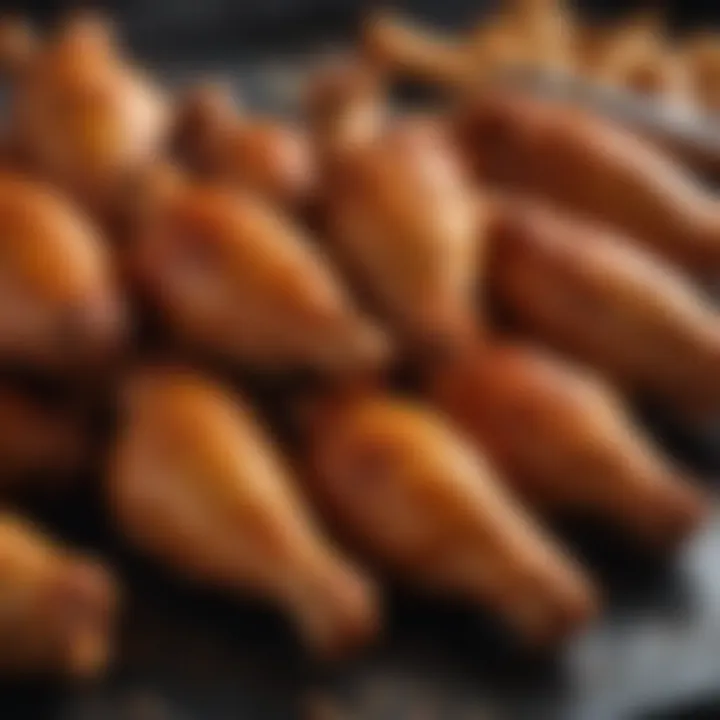
Intro
Cooking chicken wings can be a delightful experience, especially with the right equipment and technique. The air fryer has gained significant popularity for its ability to produce crispy, flavorful wings without the excessive oil typically required in traditional frying methods. This article aims to offer a thorough guide on preparing chicken wings using an air fryer, detailing various approaches that promise rich flavors and appealing textures.
From selecting the appropriate type of wings to optimal seasoning and cooking times, every detail contributes to a successful outcome. Additionally, the suggestions for serving can help elevate the dining experience. Whether you are just beginning your culinary journey or are familiar with wing preparation, this article will provide valuable insights.
Selecting the Right Wings
When it comes to chicken wings, the first step to achieving perfection is selection. Freshness plays a crucial role. Look for plump and well-colored wings, preferably organic or free-range for enhanced flavor.
- Whole vs. Cut Wings: Whole wings typically contain three parts: the drumette, flat, and tip. Cutting the wings can lead to more even cooking. However, cooking them whole can sometimes enhance the presentation.
- Frozen vs. Fresh: Frozen wings can be convenient, but ensure they are thawed properly before cooking, as this affects texture and cooking time.
Considerations about size are important as well. Larger wings often require longer cook times, which can change the texture.
Preparation Techniques
Before cooking, preparing the wings is essential. Start by rinsing them under cold water to remove any excess residue. Pat them dry thoroughly. Dry wings help achieve a better crispiness when cooked.
Marinating or seasoning the wings is another critical step. A variety of flavors can be explored with different spices, sauces, and marinades. Here are some popular options:
- Barbecue sauce for a tangy flavor
- Buffalo sauce for a spicy kick
- Soy sauce and garlic for an Asian twist
- Dry rubs consisting of smoked paprika, garlic powder, and black pepper for a savory taste
Covering the wings in seasoning and letting them marinate for a while in the fridge can enhance the flavor immensely. The ideal time for marinating is usually between 30 minutes to 2 hours.
Cooking Wings in an Air Fryer
Now that the wings are prepared, it’s time to discuss the cooking process. An air fryer operates by circulating hot air, offering the crispiness similar to frying while retaining moisture. Here’s a brief guide:
- Preheat the air fryer to 380°F (193°C). This temperature allows the wings to cook perfectly.
- Arrange the wings in a single layer within the basket, ensuring they are not overcrowded for even cooking.
- Cook for approximately 25 to 30 minutes, flipping them halfway through to ensure a uniform brownness. Check for doneness with a meat thermometer; the internal temperature should reach 165°F (74°C).
- For additional crispiness, consider giving the wings a final broil for 2 to 3 minutes, but watch them closely to avoid burning.
Serving Suggestions
Once the wings have cooked to perfection, it's important to serve them well. Presentation matters, even in casual settings.
Pairing Dips and Sides
- Blue cheese dressing or ranch dressing are traditional favorites for dipping.
- Celery and carrot sticks offer a refreshing contrast to the wings' savory flavor.
Garnishing
Consider garnishing with chopped green onions or a sprinkle of sesame seeds for added visual appeal.
Cooking chicken wings in an air fryer not only provides flavor but also a health-conscious alternative to frying.
Understanding the Air Fryer
The air fryer has become a significant appliance in many kitchens. Understanding its operation and advantages is essential for anyone wishing to master cooking chicken wings. An air fryer mimics traditional deep frying methods by circulating hot air, enabling food to cook evenly and develop a crispy texture. This technology relies on a combination of convection heating and an efficient design to deliver results that are often healthier than traditional frying methods.
The importance of recognizing how the air fryer functions cannot be overstated. By grasping the nuances of air circulation and temperature control, cooks can optimize the cooking process for better outcomes. Knowledge about the air fryer allows one to appreciate the convenience and versatility it offers in meal preparation.
The Science Behind Air Frying
Air frying utilizes rapid air technology. This creates an intense flow of hot air that surrounds the food. The heat cooks the food quickly, resulting in a texture similar to deep frying but with significantly less oil. When cooking wings in an air fryer, the moisture inside the meat is retained, while the outside crisps up due to the high heat.
This method is ideal for wings, as their fat content aids in keeping them juicy while still achieving that desired crunch. The science also shows that air frying can reduce calorie intake because less oil is needed compared to traditional frying. For those health-conscious enthusiasts, this aspect is often a primary motivator.
Comparative Advantages of Air Frying
Air frying offers various advantages over traditional cooking methods.
- Healthier Cooking Option: Using an air fryer significantly lowers the amount of oil required for cooking. Traditional frying often requires several cups of oil, increasing calorie and fat content.
- Temperature Control: Many air fryers come with adjustable temperature settings. This allows more precise cooking and can lead to better overall results.
- Speed: Air fryers typically cook food faster than conventional ovens. This efficiency can benefit busy households looking for quick meal solutions.
- Versatility: An air fryer is not limited to frying. Many can bake, roast, and grill, making them multifunctional appliances suitable for numerous recipes beyond chicken wings.
- Ease of Cleaning: Most air fryers have removable parts that are dishwasher-safe, simplifying clean-up after cooking.
In summary, understanding the air fryer is crucial for those aiming to master cooking wings. Its unique technology offers a healthier, more efficient, and versatile approach to meal preparation.
Selecting the Right Chicken Wings
Choosing the right chicken wings is crucial in achieving the perfect outcome when using an air fryer. This selection impacts not only the flavor but also the texture of the wings. Knowing the types of chicken wings available and whether to use fresh or frozen options can make a significant difference in your culinary results.
Types of Chicken Wings
Typically, chicken wings come in several varieties, influencing their preparation and flavor. The most common types are:


- Wingettes: These are the flat parts of the wing, most popular for their tender meat and ease of eating.
- Drumsticks: These are the meaty portions that resemble small drumsticks. They are often juicier than wingettes.
- Whole Wings: This option includes both the wingette and the drumstick, offering a larger serving.
Each type has its advantages. Wingettes are ideal for tossing in sauces, while drumsticks provide a satisfying bite. When considering options, it is essential to reflect on the intended style of the dish and personal preferences. Lightly seasoned wings can pair well with spicy sauces or marinades.
Fresh vs. Frozen Wings
When deciding between fresh and frozen wings, several considerations come into play. Fresh wings are preferred for their superior texture and flavor. They contain less moisture than frozen varieties and can provide better crispiness in the air fryer.
On the other hand, frozen wings are convenient and have a long shelf life. For those who may not regularly consume wings or are preparing for a gathering, purchasing frozen wings can be practical. However, it is vital to ensure proper thawing before cooking.
Here are some tips for selecting the right wings:
- Inspect the packaging for freshness.
- Check for a good balance of meat on the bone.
- Consider the size of the wings in relation to your cooking needs.
Ultimately, the choice between fresh and frozen wings depends on personal preference and availability. Understanding these distinctions will enhance your ability to produce delectable air fryer wings.
Preparation Steps
Preparation steps are critical for achieving optimal results when cooking chicken wings in an air fryer. Proper preparation not only enhances flavour and texture but also helps in ensuring even cooking. Understanding each aspect of preparation will aid in harnessing the full potential of the air fryer. As with any culinary practice, neglecting these steps can lead to less than desirable results. Thus, it is essential to focus on thawing, cleaning, and cutting your wings correctly.
Thawing Techniques
Thawing chicken wings before cooking is crucial, especially if you choose to use frozen wings. Proper thawing helps to maintain the texture and allows for even cooking. One effective method is to transfer the wings from the freezer to the refrigerator for approximately 24 hours. This slow thawing method ensures that the wings defrost while keeping them at a safe temperature.
Another method is to place the wings in a sealed bag and submerge them in cold water for about an hour. It is important to change the water every 30 minutes to ensure they stay cold. Avoid thawing at room temperature, as this increases the risk of bacterial growth. Thawing correctly not only preserves the quality of the meat but also ensures the seasonings absorb well during cooking.
Cleaning and Drying Wings
Before seasoning and cooking, it's important to clean the chicken wings properly. Rinse the wings under cold water to remove any residues from processing. After rinsing, pat them dry with paper towels. This step is crucial; excess moisture can lead to steam instead of crispiness in the air fryer. The drier the surface of the wings, the better the crisp will become during cooking. Ensuring that the wings are clean and dry enhances overall texture and allows the seasonings to stick better.
Cutting and Separation
If you are using whole wings, it may be necessary to cut them into smaller parts: the drumette, the flat, and the tip. Cutting the wings makes for easier handling and can also reduce cooking time. Use a sharp knife or kitchen shears for this task to achieve clean cuts. The separation will ensure even cooking and allow for better seasoning coverage.
Making sure each wing is cut correctly also improves presentation when serving. Properly prepared wings will not only taste better but also look appealing to your guests. In summary, focus on these preparation steps to elevate the quality of your air fryer chicken wings.
Seasoning Your Wings
Seasoning is a critical aspect of cooking chicken wings in an air fryer. Proper seasoning can significantly enhance the flavor profile, ensuring that the wings are more than just a vehicle for sauces. It is essential to consider both the base flavors and the balance between seasoning types. A well-seasoned wing can elevate an average meal into a savory experience. Furthermore, seasoning allows for a wide variety of flavor possibilities, catering to different tastes and preferences.
Basic Seasoning Techniques
The foundation of good wing seasoning begins with salt and pepper. Salt acts as a flavor enhancer, while pepper adds a subtle kick. You can use various forms of salt—kosher, sea, or table salt depending on preference. A light dusting of seasoning can enhance the natural flavor without overwhelming it.
In addition to salt and pepper, other seasonings can include garlic powder, onion powder, or smoked paprika. These elements offer depth and complexity. Simply toss the wings with your chosen seasonings in a bowl or a plastic bag until evenly coated. You do not need to overdo it; a light layer is sufficient to bring out flavor without making the wings taste salty or overpowering.
Exploring Marinades
Marinades provide a different approach to flavoring wings. A marinade typically contains an acid, such as vinegar or citrus juice, which helps tenderize the meat while infusing it with flavor. You can use different ingredients such as soy sauce, honey, mustard, or herbs to create a unique mixture.
To marinate, place the chicken wings in a large resealable bag or bowl. Pour the marinade over the wings, ensuring they are completely covered. Seal the bag or cover the bowl, then refrigerate for one to several hours, depending on the flavor intensity desired. Longer marination times generally result in more pronounced flavors, but be cautious; excessive marination can cause the meat to become mushy.
Dry Rubs vs. Wet Marinades
When deciding between dry rubs and wet marinades, consider your desired end flavor and texture. Dry rubs are a mixture of spices and herbs that create a crust as the wings cook. They are easy to apply and do not require additional equipment for marination. However, they may not penetrate the meat as deeply as marinades.
Wet marinades, on the other hand, allow flavors to permeate the chicken. They also can provide moisture, which is beneficial for cooking methods that may dry out meat, like air frying. However, if your aim is a crispy exterior, dry rubs may be the better choice, as wet marinades can add moisture that prevents crispiness.
In summary, seasoning your wings effectively can enhance flavor while providing a range of textures and results. Experimenting with various techniques—whether basic seasoning, marinades, or choosing between dry rubs and wet marinades—can contribute to mastering the culinary art of air-fried chicken wings.
Cooking Process in the Air Fryer
The cooking process in an air fryer is a crucial element in achieving perfectly cooked chicken wings. Understanding the steps involved is essential to maximizing the device's potential and obtaining the desired texture and flavor in your wings. An air fryer circulates hot air, giving the wings a crisp exterior while keeping the inside moist. This method not only reduces cooking time but also cuts down on oil usage compared to traditional frying methods.
Successful air frying involves more than just tossing wings in the basket. Factors such as preheating, arrangement of wings, and adhering to the correct cooking times and temperatures play significant roles. Each of these components contributes to a balanced cooking process that transforms your wings into a delightful meal.
Preheating the Air Fryer
Preheating your air fryer may seem like an optional step; however, it is very important. Just like an oven, an air fryer needs to reach the desired temperature to begin effective cooking. Preheating helps ensure that heat is distributed evenly throughout the cooking process, which leads to consistent results. Skipping this step can result in uneven cooking, making parts of the wings undercooked or overly dry.
Generally, preheating takes about five minutes. Set the air fryer temperature to 375°F, which is a recommended setting for chicken wings. Make sure the fryer is empty during this step.
Arranging the Wings in the Basket
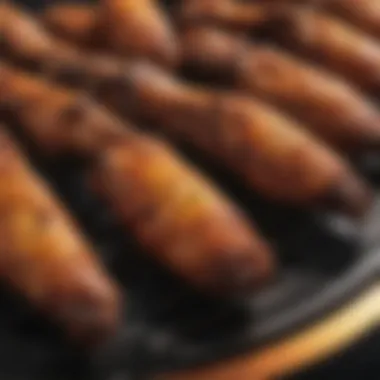
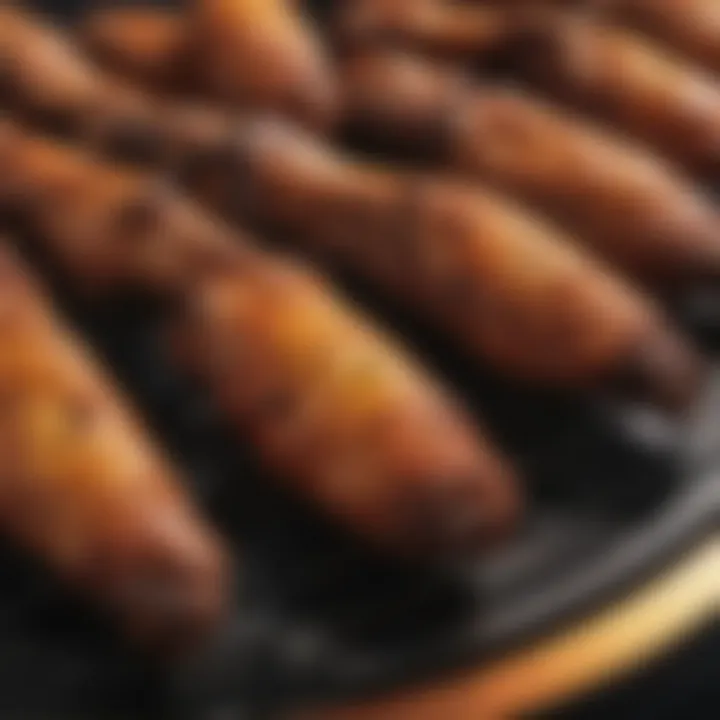
How you arrange the wings in the basket directly impacts the cooking results. Overcrowding the basket can obstruct air circulation, leading to uneven cooking. It's ideal to place the wings in a single layer, giving space between each piece. This allows hot air to circulate effectively around each wing, resulting in optimal crispness. You may need to cook in batches if you have a large quantity of wings.
To enhance air flow, consider turning the wings halfway through the cooking cycle. This ensures all sides receive equal exposure to the hot air.
Optimal Cooking Times and Temperatures
Understanding cooking times and temperatures is essential to achieving ideal wing texture. Most air fryers operate efficiently at temperatures ranging from 360°F to 400°F. A common temperature for cooking chicken wings is 375°F. As for cooking times, wings typically take about 25 to 30 minutes. It is advisable to check the wings at the halfway mark and shake the basket to promote even cooking.
Internal temperature is critical. The FDA recommends that chicken reach an internal temperature of 165°F. A meat thermometer is a useful tool for ensuring food safety. Additionally, for crispier results, consider increasing the temperature slightly during the final few minutes of cooking.
Always ensure that your wings are cooked to the proper internal temperature to avoid foodborne illness.
By understanding and implementing these cooking processes in your air fryer, you will be well on your way to mastering the art of cooking wings. Each step contributes to the overall quality of the final product. When done correctly, air fryer wings can rival those prepared using more traditional techniques.
Post-Cooking Techniques
Post-cooking techniques play a crucial role in ensuring that the chicken wings not only taste good but also meet texture expectations. After using an air fryer, the techniques applied right after cooking can greatly impact the final enjoyment of the dish. This is where you can refine the flavor and achieve the perfect mouthfeel. Focusing on checking for doneness and enhancing crispiness, these techniques are foundational for delivering exceptional chicken wings.
Checking for Doneness
Once the cooking time is completed, verifying the doneness of chicken wings becomes essential. Simply relying on the timer is not sufficient; one must check the internal temperature as well. Using a food thermometer, ensure the thickest part of the wings reaches an internal temperature of 165°F (75°C). This step is vital for food safety, ensuring harmful bacteria are eliminated.
Visual indicators are also relevant. The wings should appear golden brown, and the skin should look crisp. Puncturing one of the wings is advisable. If juices run clear and not pink, it indicates the wing is cooked through. In contrast, if the juices remain pink, it's sensible to return the wings to the air fryer for additional cooking time, typically in 2-3 minute increments, checking until done. This conscientious approach will guarantee safe and enjoyable consumption.
Crispiness Enhancement Techniques
Achieving the desired crispiness can be a defining characteristic of air-fried chicken wings. After checking for doneness, several techniques can enhance this quality. One effective method involves an additional blast of heat. Setting the air fryer to a higher temperature, around 400°F (200°C), and cooking for an extra 3-5 minutes can create a delightful crunch.
Another viable technique involves removing the wings and letting them rest on a wire rack for a few minutes. This allows air to circulate around them, preventing moisture from softening the skin. If a more pronounced crisp is desired, consider applying a light coating of oil or cooking spray before this extra cook. Just a small amount can significantly enhance the surface texture without overpowering the flavor.
In summary, post-cooking techniques like checking for doneness and implementing strategies for improved crispiness are essential. These steps ensure that the wings not only meet safety standards but are also served with an appealing texture that enhances the overall dish. For detailed resources, you can explore more on cooking techniques at Britannica and check popular cooking discussions on Reddit.
Serving Suggestions
Serving suggestions play a crucial role in enhancing the overall dining experience when enjoying air fryer chicken wings. Properly presented wings not only appeal to the eye but can also elevate their flavors. Understanding what sauces and sides complement your wings can significantly contribute to satisfaction during a meal.
One key benefit of thoughtfully selecting accompaniments is that it can cater to a variety of taste preferences. Whether hosting a casual gathering or preparing a weekday dinner, knowing how to serve air fryer wings well makes a difference. Consideration of flavors, textures, and even dietary restrictions ensures that everyone can find something they enjoy.
Dipping Sauces
Dipping sauces are essential for adding flavor depth to chicken wings. An array of sauces can transform a basic wing into an unforgettable culinary delight. Classic options include:
- Buffalo Sauce: Known for its spicy and tangy profile, Buffalo sauce is a staple in wing culture. Its vinegar base balances the richness of the fried skin, making it a crowd favorite.
- Ranch Dressing: The creamy consistency and herbal notes of ranch provide a cooling contrast to spicy wings. This is especially popular in many gatherings.
- Blue Cheese Dressing: For those who appreciate strong flavors, blue cheese adds a pungent touch. The sharpness pairs well with the heat of Buffalo wings.
- Honey Mustard: A sweeter option, honey mustard offers a contrasting flavor to savory wings, appealing to those who prefer milder tastes.
Having multiple sauces encourages variety. Offer a selection on the table to allow guests to mix and match according to their own preferences.
Pairing with Side Dishes
Sides complementing chicken wings contribute to the roundness of a meal. They support the flavors of the wings while providing different textures. Here are some popular options to consider:
- Celery and Carrot Sticks: A traditional pairing, these veggies provide crunch and freshness, which can help cleanse the palate between bites of rich chicken wings.
- Coleslaw: The creamy tang of coleslaw offers a refreshing crunch that contrasts nicely with the crispy wings. Adding some heat, like a drizzle of hot sauce on coleslaw, can enhance the overall flavor profile.
- Potato Wedges: Crispy potato wedges can make for a satisfying side. Well-seasoned, they can complement the wings well, providing a nice balance.
- Corn on the Cob: Especially during summer, fresh corn can be a delightful side. It adds a sweetness that pairs well with spicy flavors.
- Garlic Bread: For a more filling option, garlic bread or cheesy breadsticks can be excellent. They add richness and a comforting touch to the meal.
Common Mistakes to Avoid
Recognizing common pitfalls when cooking chicken wings in an air fryer is crucial for achieving optimal results. Understanding these mistakes can significantly enhance the flavor and texture of your wings, ensuring they are perfectly crisp and juicy. By avoiding these errors, cooks can save both time and ingredients, leading to a more rewarding culinary experience.
Overcrowding the Air Fryer
One of the most frequent mistakes is overcrowding the air fryer basket. When wings are packed too closely together, there is limited space for air to circulate. This hampers the cooking process and results in unevenly cooked wings. Instead of achieving that desired crispiness, the wings may turn out soggy or even undercooked.
To avoid overcrowding:
- Cook in Batches: Divide the wings into smaller portions. Cooking smaller quantities allows hot air to flow freely, enhancing the cooking efficiency.
- Single Layer Arrangement: Lay the wings in a single layer. This placement provides each piece adequate exposure to heat, promoting an even cook and a satisfying crunch.
- Monitor the Size: Check the size of your air fryer. Some models can handle a larger load, while others may require more cautious approaches.
"A well-organized cooking method leads to better results and less frustration."
Not Preheating the Device
Another mistake to avoid is neglecting to preheat the air fryer. Preheating allows the appliance to reach the desired temperature before adding the wings. This step is important for achieving an immediate cooking reaction, which helps lock in the juices and promote crispiness. Skipping this critical phase can lead to wings that are not as evenly cooked or that lack the desired texture.
Tips for effective preheating:
- Follow Manufacturer Guidelines: Different air fryer models have varying preheating times. Refer to the user manual for specific instructions.
- Set a Timer: Set the air fryer to preheat for about 3-5 minutes. This small investment of time enhances the outcome significantly.
- Use Appropriate Temperature: Generally, preheating to around 375°F (190°C) is ideal for chicken wings. This temperature ensures a good sear and facilitates thorough cooking.
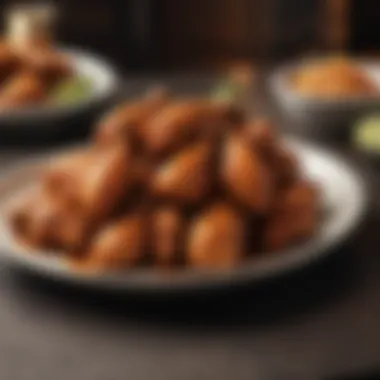
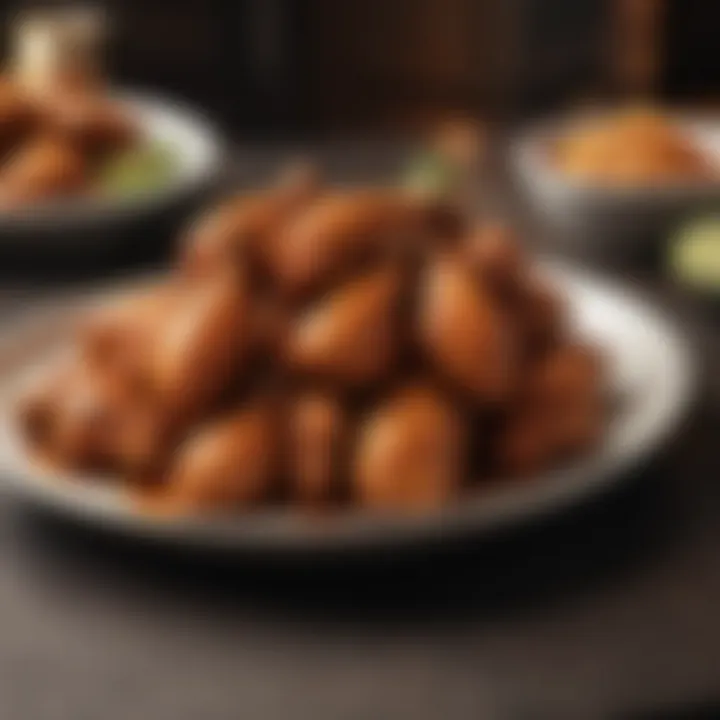
By avoiding overcrowding and ensuring preheating, cooks can achieve better results. Good preparation and technique can elevate the cooking experience, leading to air-fried chicken wings that are crispy on the outside and juicy on the inside.
Cleaning and Maintenance of the Air Fryer
The cleaning and maintenance of an air fryer often go overlooked, but they are crucial for both the longevity of the appliance and the quality of the food it cooks. Regular cleaning ensures that any leftover grease, food particles, or debris does not compromise the taste and safety of your next cooking session. Additionally, a well-maintained air fryer operates more efficiently, heating up quicker and ensuring more consistent cooking results. Therefore, investing time in cleaning and maintaining your air fryer can enhance not only the durability of the machine but the overall cooking experience.
Proper Cleaning Techniques
Cleaning your air fryer can be simple. It typically involves a few straightforward steps:
- Unplug the Device: Always begin by turning off and unplugging your air fryer. It is essential for safety.
- Remove and Wash Components: Take out the basket and tray. These parts are usually dishwasher-safe, but washing by hand is often safer to prevent damage. Use warm soapy water and a non-abrasive sponge to clean surfaces. Rinse well and dry thoroughly.
- Wipe Down the Exterior: The outer surface can become quite grimy. Use a damp cloth and a mild cleaning agent to wipe it clean. Avoid using abrasive materials that could scratch the surface.
- Clean the Heating Element: If your air fryer has a heating element, gently wipe it with a damp cloth or sponge to remove any food particles. Make sure the element is cool before doing this.
- Avoid Harsh Chemicals: Using overly strong cleaners can damage the non-stick coating of the fryer. Stick to mild dish soap or a vinegar solution to avoid issues.
Maintaining a regular cleaning routine is vital. Aim to clean your air fryer after every use or at least every few times it is used to prevent the buildup of grease and bacteria.
Long-term Maintenance Tips
Long-term maintenance of your air fryer involves a few strategies:
- Check Cables and Connections: Regularly inspect the power cord and connections for any signs of wear. If you notice damage, replace the unit to avoid hazards.
- Avoiding Overloading: Each time you cook, do not overcrowd the basket. Doing so can lead to uneven cooking and may require more frequent cleaning.
- Utilize Liner Papers: Consider using air fryer liner or parchment papers. These can help catch drips and crumbs, reducing the cleaning effort required after cooking.
- Store Properly: After cleaning, store your air fryer in a dry place. Keeping it covered can help prevent dust accumulation if you do not use it frequently.
Following these practices will help maintain your air fryer in tip-top shape. Not only does this ensure better cooking results, but it also prolongs the lifespan of your appliance, making it a valuable asset in your kitchen.
Variations of Air Fryer Wings
Exploring variations of air fryer wings adds depth to your culinary repertoire. It allows you to adapt simple chicken wings into diverse flavor profiles, catering to different tastes and preferences. Each variant brings unique ingredients and methods, permitting creativity in the kitchen while still benefiting from the efficient cooking method the air fryer provides. This section will delve into three prominent styles of wings: Buffalo, Asian-inspired, and Smoky BBQ. Each of these styles has its roots in different culinary traditions, offering not only distinct tastes but also varying nutrition profiles and preparation approaches.
Equipped with this knowledge, you can masterfully create wings that are perfect for game days, gatherings, or simple family meals.
Buffalo Style Wings
Buffalo style wings are perhaps the most recognized variant in the wing universe. Originating from Buffalo, New York, this classic style offers a spicy and tangy experience. The cooking technique is straightforward; typically, wings are deep-fried and then tossed in a mixture of hot sauce and melted butter. However, using an air fryer allows you to achieve the crispy texture without excessive oil. This method not only makes the process easier but also healthier.
To prepare Buffalo wings in an air fryer:
- Thaw the Wings: Always ensure wings are completely thawed for even cooking.
- Season Lightly: A simple sprinkle of salt and pepper is sufficient before air frying.
- Air Fry: AT 400°F (204°C) for approximately 25 minutes, flipping halfway through guarantees even crisping.
- Buffalo Sauce Toss: After frying, toss wings in your favorite Buffalo sauce, ensuring they're well-coated.
This style is great for those who appreciate a bit of heat, complemented by the richness of butter.
Asian-inspired Wings
Asian-inspired wings present an entirely different flavor profile, focusing on sweet, tangy, or even savory elements. Ingredients such as soy sauce, ginger, garlic, and sesame oil can play a significant role, giving a delightful umami experience. One popular version includes a sticky glaze made with hoisin sauce and a touch of honey.
Here’s a basic approach to create them:
- Marinate: Start by marinating wings for at least an hour. A quick mix of soy sauce, honey, garlic, and ginger works wonders.
- Air Fry: Cook at 380°F (193°C) for 22 to 25 minutes. Keep an eye on them to prevent burning due to sugar content in the marinade.
- Final Touch: After cooking, you can garnish with sesame seeds and chopped green onions for presentation and added flavor.
This variant can appeal to those looking for a more subtle spice and rich flavors.
Smoky BBQ Wings
Smoky BBQ wings shine with their bold and hearty profile. The combination of BBQ sauce and a hint of smoke creates a satisfying dish. While traditional preparation often requires smoking or grilling, the air fryer simplifies this without sacrificing depth of flavor.
To prepare these wings:
- Dry Rub: Season wings with a mix of paprika, brown sugar, garlic powder, and a touch of cayenne for heat.
- Air Fry: Set your air fryer to 390°F (199°C) and cook for around 25 minutes, flipping during the process.
- BBQ Sauce Application: After cooking, apply your preferred BBQ sauce and return to the fryer for an extra 5 minutes to caramelize the sauce.
These wings are perfect for those who enjoy a sweet and spicy kick, making them an excellent choice for gatherings or casual dinners.
Each variation of wings offers unique opportunities to experiment and discover flavors that excite your palate. Adapting classic recipes for air frying not only provides convenience but also encourages home cooks to step beyond traditional cooking methods.
Nutritional Considerations
Understanding the nutritional aspects of cooking wings in an air fryer is essential for making informed dietary choices. Air frying is often seen as a healthier alternative to traditional frying methods. This cooking technique uses hot air circulation instead of submerging food in oil. Consequently, this can result in lower fat content and fewer calories in the final dish. The relevance of focusing on nutritional considerations becomes evident as more individuals seek ways to enjoy their favorite foods while maintaining a balanced diet.
Health Benefits of Air Frying
Air frying chicken wings does not simply reduce fat; it also preserves many nutrients found in the ingredients. Unlike deep frying, which can degrade certain vitamins, air frying maintains a better nutritional profile. Here are some key health benefits:
- Reduced Fat Intake: Air frying uses significantly less oil than traditional frying. This means lower saturated fat consumption, which is beneficial for heart health.
- Retained Nutrients: The rapid cooking process can help retain vitamins and minerals, particularly if wings are cooked at the right temperature and time.
- Fewer Harmful Compounds: Cooking at lower temperatures reduces the formation of harmful compounds, which may occur during high-heat frying. This aspect makes air fryers a safer choice.
Caloric Comparisons
When evaluating the caloric content of air-fried wings versus traditional fried wings, the differences are striking. Here’s a simple overview:
- Air-Fried Wings: Depending on the specific recipe and oil used, air-fried wings can contain approximately 150-200 calories per serving.
- Deep-Fried Wings: In contrast, the same serving size of deep-fried wings may range from 300-400 calories, primarily due to the oil absorption during frying.
In terms of macronutrient composition, air-fried wings typically present lower fat content while maintaining comparable protein levels. This makes them a more favorable option for those monitoring caloric intake without sacrificing flavor.
"Choosing to air fry instead of deep fry gives food lovers a chance to indulge while being mindful of health."















